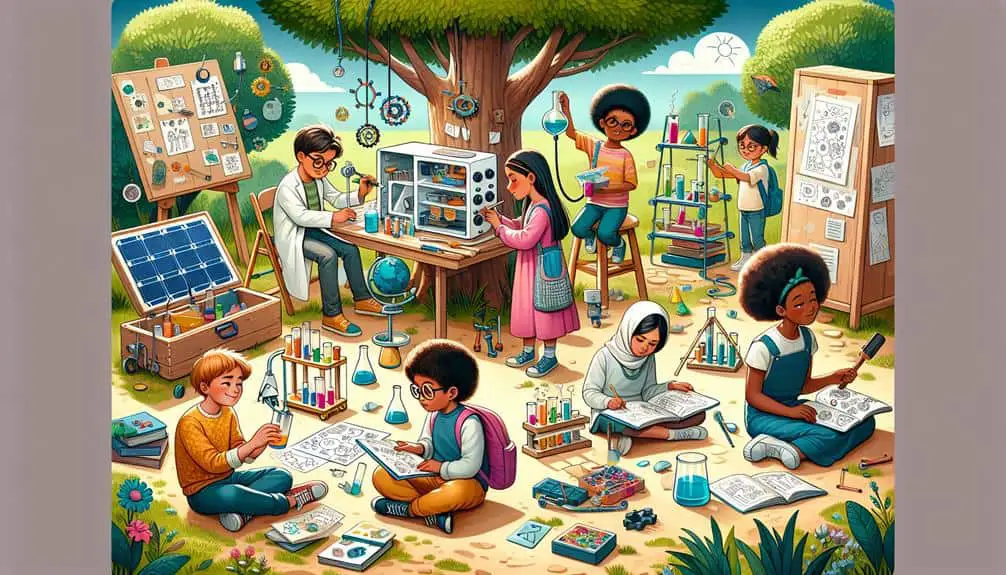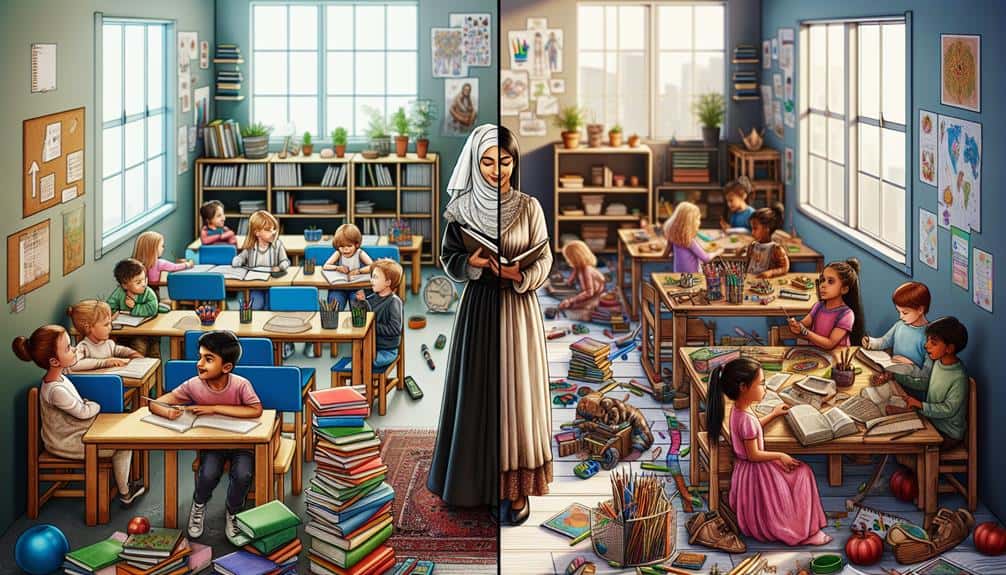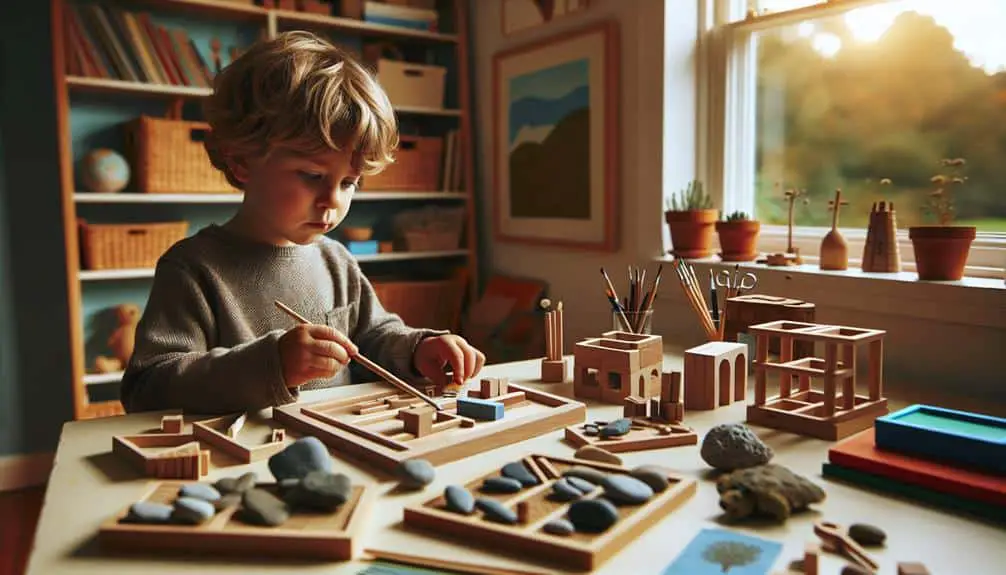Get hands-on with engaging project-based learning for homeschooling. Try interactive science experiments like chemistry reactions and physics simulations. Build robots and bridges to learn about engineering principles. Travel back in time with historical reenactments and work on art projects for creativity. Experiment with cooking different foods and study the environment through wildlife observation. Also, get involved in community service like donation drives and charity partnerships. These activities offer a broad range of learning opportunities for homeschoolers to explore. More exciting ideas await!
Key Points
- Hands-on science experiments with chemical reactions, color changes, and temperature variations.
- DIY engineering projects, robotics challenges, and bridge building for understanding engineering principles.
- Historical reenactments, costume creation, and role-playing for immersive learning experiences.
- Culinary adventures, cooking challenges, and exploring global cuisines for practical skills development.
- Community service involvement through donation drives, volunteering opportunities, and charity partnerships for real-world impact.
Science Experiments
Explore various engaging and hands-on science experiments as part of your homeschooling project-based learning curriculum. Immerse yourself in the world of chemical reactions by conducting experiments that showcase the exciting transformations that occur when different substances interact. Witness the magic of color changes, gas production, or even temperature variations as you mix various compounds together.
Moreover, venture into the domain of physics simulations where you can explore concepts such as motion, forces, and energy in a virtual environment. Utilize simulation software to conduct experiments that may not be feasible in a traditional homeschool setting, allowing you to visualize and understand complex physical phenomena in an interactive way.
Historical Reenactments
Get ready to transport yourself back in time through historical reenactments.
You can engage in costume creation to embody a specific era authentically.
Role-playing scenarios will allow you to immerse yourself in the historical context, making learning both fun and educational.
Costume Creation
Creating historically accurate costumes for your homeschool historical reenactments can greatly enhance the immersive learning experience for you and your child. Character development and storytelling are pivotal elements in bringing history to life through reenactments.
When crafting costumes, consider the historical context of the character your child will portray. Researching clothing styles, accessories, and colors of a particular era can aid in creating authentic costumes that reflect the time period accurately.
Fabric selection plays an important role in costume creation. Opt for fabrics commonly used during the historical period being reenacted. Cotton, linen, wool, and silk were prevalent in various eras and can add authenticity to the costumes.
Additionally, prop making can complement the costumes and aid in storytelling. Handmade props such as hats, jewelry, shoes, or tools can further immerse your child in the historical role they're embodying.
Role-playing Scenarios
Choose historically significant events to reenact in order to engage your child in immersive learning experiences through role-playing scenarios. Historical reenactments offer a hands-on approach to learning by allowing your child to step into the shoes of individuals from the past. By incorporating improv games, your child can enhance their creativity and critical thinking skills while delving into character development.
Through role-playing scenarios, your child can learn valuable lessons in conflict resolution and decision-making. Encourage them to analyze the motivations of historical figures and navigate through the challenges they faced. This interactive learning experience provides a deeper understanding of the complexities of historical events and the impact of individual actions.
To guarantee a successful role-playing session, provide your child with background information on the chosen event and characters involved. Encourage them to research primary sources and develop a script or outline for the reenactment.
DIY Engineering Projects
Begin a journey of hands-on discovery by diving into a variety of DIY engineering projects tailored for homeschoolers.
Engaging in a robotics challenge can be an exciting way to learn about circuit design. Build simple robots using basic components like motors, sensors, and microcontrollers, then program them to perform specific tasks, fostering both creativity and technical skills.
Exploring simple machines offers a practical approach to understanding fundamental engineering principles. Constructing pulleys, levers, and inclined planes can showcase the concepts of force, motion, and mechanical advantage in a tangible way.
Additionally, bridge building projects provide an opportunity to investigate structural engineering. Experiment with different materials and designs to construct bridges capable of supporting various weights, applying physics and mathematics to create stable structures.
Artistic Creations
How can you infuse creativity into your homeschooling journey through engaging in Artistic Creations?
One way is by exploring mixed media projects that combine various materials such as paint, paper, fabric, and found objects to create unique and visually appealing artwork. Encourage your child to experiment with different textures, colors, and techniques to express their creativity in diverse ways.
Another exciting avenue to explore is sculpture techniques. This hands-on approach allows children to work with three-dimensional forms using materials like clay, wire, or even recycled materials. Sculpting not only enhances fine motor skills but also fosters spatial awareness and creativity.
Integrating mixed media and sculpture techniques into your homeschooling curriculum provides an excellent opportunity for your child to develop artistic skills, think critically, and problem-solve creatively. These projects can also serve as a means of self-expression and a way to explore different art styles and movements.
Embrace the world of Artistic Creations to nurture your child's artistic talents and foster a love for the arts.
Culinary Adventures
Get ready to dive into exciting culinary adventures in your homeschooling journey.
From cooking challenges that test your creativity and skills to exploring global cuisines from around the world, there's a whole world of flavors waiting for you to discover.
Through these hands-on experiences, you can learn about different cultures, ingredients, and cooking techniques while honing your culinary talents.
Cooking Challenges
Begin exciting culinary adventures by challenging yourself with creative cooking projects that will enhance your skills and palate.
One engaging idea is to organize a recipe swap with friends or family. Each participant can share a favorite recipe, and everyone can try making the dishes at home. This activity not only introduces new flavors but also promotes a sense of community and sharing.
Another fun challenge is to host a kitchen competition. Divide into teams and set a theme or specific ingredients to use. Let your creativity shine as you work together to prepare delicious dishes within a time limit. This activity encourages teamwork, problem-solving, and culinary innovation.
For a twist, try an ingredient mystery challenge. Have someone select a mystery ingredient for you to incorporate into a dish. Test your cooking skills by adapting recipes to include this unexpected element.
Global Cuisine Exploration
Begin a flavorful journey of discovery through global cuisine as you explore diverse culinary traditions from around the world. Explore cultural celebrations by preparing traditional dishes that hold significance in various cultures. Embrace the culinary diversity that exists worldwide, each dish offering a unique glimpse into a community's history and values.
Investigate cooking techniques from different regions, such as stir-frying in Asian cuisine or slow-cooking in Mediterranean dishes. Experiment with spices and flavors that are emblematic of specific countries, allowing your taste buds to travel to far-off lands without leaving your kitchen.
As you commence on this culinary adventure, consider delving into global cuisine through themed meals that coincide with cultural events or holidays. This can deepen your understanding of various traditions and provide a hands-on approach to learning about different cultures.
Immerse yourself in the rich tapestry of global cuisine, savoring the interconnectedness of food and culture that transcends borders and unites people around the world.
Environmental Studies
Begin an immersive journey into environmental studies through hands-on projects that foster a deep understanding of ecological systems and sustainability.
Start by engaging in wildlife observation to learn about local fauna and their habitats. Create a wildlife journal to document your findings and track changes over time.
Eco-friendly gardening offers a practical way to support the environment. Design a garden using native plants that attract pollinators and provide habitats for wildlife. Implement composting to reduce waste and enrich the soil naturally.
To tackle pollution prevention, conduct a waste audit at home to identify areas where you can reduce, reuse, and recycle. Explore the concept of renewable energy sources like solar panels and wind turbines. Calculate your household energy consumption and brainstorm ways to decrease your carbon footprint.
Through these hands-on environmental projects, you'll develop a greater appreciation for nature and gain valuable skills in sustainability practices.
Experiment with different approaches and observe the positive impact of your actions on the environment.
Community Service Initiatives
Engage in meaningful community service initiatives that allow you to make a positive impact while applying your skills and knowledge gained from environmental studies projects. By participating in donation drives and volunteering opportunities, you can actively contribute to causes that align with your environmental values.
Here are four ways you can get involved in community service initiatives:
- Donation Drives: Organize a donation drive in your neighborhood or homeschooling community to collect items such as clothes, books, or electronics for local charities or environmental organizations.
- Volunteering Opportunities: Seek out volunteering opportunities at wildlife sanctuaries, beach cleanups, or community gardens to directly engage in hands-on environmental conservation efforts.
- Fundraising Events: Host a fundraising event like a bake sale, car wash, or online auction to raise money for environmental causes or local charities focused on sustainability.
- Charity Partnerships: Partner with established environmental charities or organizations to support their initiatives through fundraising, awareness campaigns, or volunteer work, amplifying the impact of your community service efforts.
Frequently Asked Questions
How Can Homeschoolers Incorporate Technology in Project-Based Learning?
You can enhance project-based learning by integrating technology. Utilize online collaboration platforms to connect with peers and experts. Explore interactive tools like virtual simulations and educational apps to make lessons engaging and dynamic.
What Are Some Budget-Friendly Project Ideas for Homeschoolers?
Looking for budget-friendly project ideas? Why not explore outdoor exploration and nature crafts? Upcycling and recycling projects offer creative opportunities that are both cost-effective and environmentally friendly. Get ready to learn and create!
Are There Any Virtual Project-Based Learning Resources Available?
Yes, there are numerous online platforms offering interactive tools for virtual project-based learning. Explore websites like Khan Academy, Coursera, and Scratch for a wide range of educational projects that can enhance your homeschooling experience.
How Can Homeschoolers Collaborate With Other Students on Projects?
In a world where connections transcend borders, online platforms offer homeschoolers a gateway to collaborate on group activities with peers globally. Embrace this digital domain to foster creativity and teamwork in projects.
What Are Some Ways to Assess Project-Based Learning Outcomes at Home?
To effectively assess project-based learning outcomes at home, you can create rubrics outlining expectations, encourage peer evaluation for diverse perspectives, utilize portfolio assessments to track progress, and prompt self-reflection for personal growth and insight.



